From Jungle Tool to Movie Legend: The History of the Machete
November 11th, 2025

Few tools have traveled a path as wild and varied as the machete. What began as a simple agricultural blade for clearing crops and carving paths through dense jungles has evolved into one of the most recognizable symbols of strength and survival. The machete's story stretches from the farms and forests of Latin America to the silver screens of Hollywood, where it transformed from a humble utility knife into a cinematic icon. Understanding where it came from reveals why this rugged blade remains one of the most practical and enduring tools ever made.
Origins of the Machete
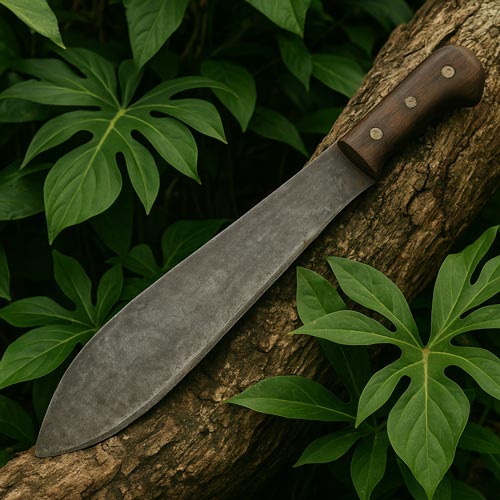
The machete's roots stretch back centuries, evolving from early agricultural blades used by indigenous peoples and colonial settlers across Central and South America, Africa, and Southeast Asia. These early tools were designed for one purpose: survival. A farmer could use a single machete to clear brush, harvest sugarcane, and cut through dense jungle. In regions where the terrain was harsh and the vegetation relentless, the machete became an extension of the human hand. Its versatility made it indispensable for daily life, serving not just as a tool but also as a means of protection against predators and rival tribes.
The word "machete" itself comes from the Spanish "macho," meaning sledgehammer or strong. Spanish explorers and settlers brought the tool to new lands, where it adapted to local needs and materials. Over time, different regions developed their own variations: the bolo in the Philippines, the panga in Africa, and the cutlass-style machete in the Caribbean. Each design reflected its environment, shaped by the types of plants, trees, and work common to that area. The machete's simplicity and effectiveness ensured that it spread rapidly across continents, transcending cultures and occupations alike.
Types of Machetes Around the World

As the machete spread across continents, different cultures adapted the blade to suit their unique environments and tasks. Each variation reflects not only local needs but also the craftsmanship and traditions of the people who forged it. Here are some of the most recognizable types of machetes used around the world today.
Parang Machete: Originating from Malaysia and Indonesia, the parang has a shorter, heavier blade with a curved edge designed to power through thick vegetation and vines. Its design gives it more chopping strength than a typical Latin machete, making it ideal for dense jungle work.
Panga Machete: Common throughout Africa, the panga has a broad, forward-curved tip that adds weight to the swing. This shape gives it excellent momentum for cutting tall grass, small trees, or sugarcane. The panga's wide belly also makes it effective for slicing and light digging.
Latin Machete: The most classic and recognizable form, the Latin machete features a straight, balanced blade that works well for general use. It's the go-to design across the Caribbean and South America, used for farming, trailblazing, and even cooking in rural areas.
Bolo Machete: Popular in the Philippines, the bolo has a widened tip for extra weight and force at the end of the swing. Originally used for agriculture and harvesting crops like rice and coconuts, it also became a practical weapon during times of conflict.
Sawback Machete: This modern variation adds a row of saw teeth along the spine of the blade, turning the tool into a versatile hybrid for campers and survivalists. The sawback design allows for cutting wood or bone without switching tools, making it a favorite for outdoor enthusiasts.
Tapanga Machete: Designed with a unique angled tip, the tapanga is often used in West Africa. The forward-heavy blade makes it great for splitting or chopping, while the flat tip can be used for scraping or hammering tasks. It's a true multi-purpose tool for working in tough terrain.
From the curved elegance of the parang to the brute power of the panga, each variation tells the story of a culture's relationship with the land. Together, they show how the machete evolved from a regional farm tool into a universal symbol of strength, endurance, and adaptability.
The Machete in War and Revolution
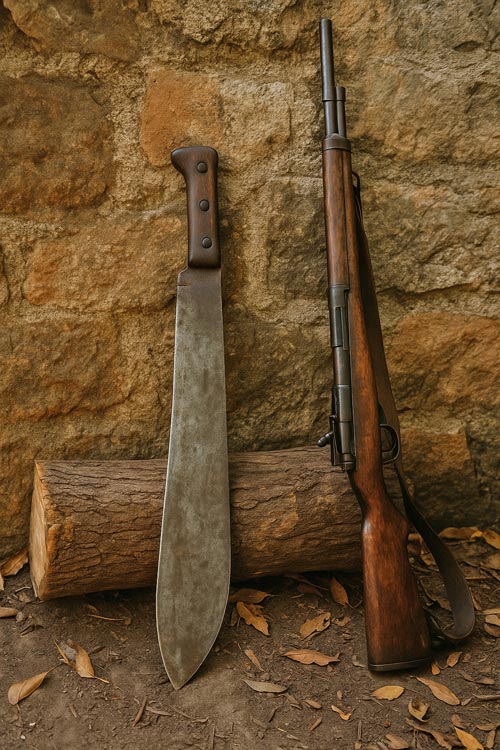
While the machete began as a tool of labor, history turned it into a symbol of rebellion and liberation. Across Latin America and the Caribbean, farmers and workers who once used machetes to harvest crops soon wielded them in uprisings against colonial powers. During the Haitian Revolution of the late 1700s, enslaved people used machetes as both weapons and emblems of resistance, proving that a simple tool could become a powerful equalizer. Similar stories echoed across Cuba and the Philippines, where the machete and bolo became weapons of choice for guerrilla fighters who lacked formal arms but possessed deep determination.
Even in modern times, the machete's legacy as a weapon of necessity remains part of its cultural image. Military and survival organizations around the world have adapted machete-style blades for field use, blending traditional designs with modern materials. Whether in the hands of revolutionaries or explorers, the machete has always represented self-reliance and strength. Its dual nature, a tool for creation and destruction, makes it one of the most symbolic blades in human history.
The Machete in Modern Culture and Film
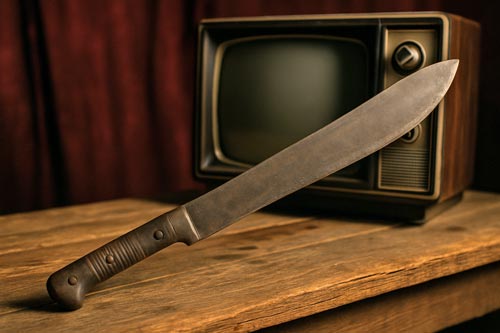
In modern times, the machete has become much more than a practical tool; it's a pop culture icon. Hollywood embraced its raw, rugged image decades ago, using it to symbolize survival, danger, and power. From classic jungle adventures to modern action films, the machete often appears as the weapon of choice for heroes and villains alike. It's featured in everything from old Tarzan movies to the hands of Rambo, Crocodile Dundee, and even the horror antihero from the "Machete" film series. Its bold silhouette instantly communicates toughness and self-reliance, making it one of cinema's most enduring visual symbols.
But the machete's presence in entertainment isn't limited to action films. It has also appeared in documentaries and survival shows, where its real-world usefulness takes center stage. Survival experts and outdoor enthusiasts frequently highlight the machete's practicality, demonstrating how it can build shelters, prepare food, and clear paths in the wild. These modern portrayals help keep the machete's reputation alive, not as a relic of the past, but as a tool that continues to prove its worth in the present day.
The Machete as a Modern Survival Tool
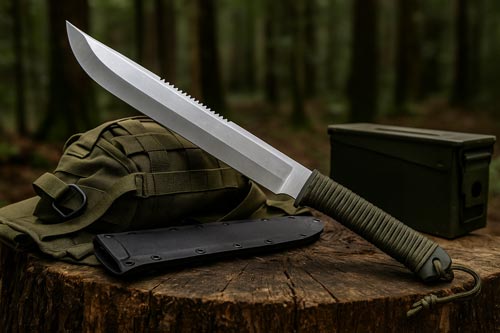
Beyond movies and folklore, the machete continues to prove its value as one of the most reliable survival tools in the world. Campers, preppers, and outdoor enthusiasts rely on it for chopping wood, clearing brush, building shelters, and even preparing food. Its long reach and balanced weight make it a perfect in-between tool, capable of handling jobs that would normally require both a knife and a hatchet. Unlike many specialized blades, a well-made machete doesn't need complex maintenance, just a sharp edge, a steady hand, and a respect for what it can do.
Modern machetes are often designed with specific users in mind. Bushcraft experts prefer heavy-duty carbon steel blades for power and durability, while hikers and survivalists may choose lightweight stainless steel models that resist rust in humid environments. Some modern versions include added features like sawback spines, serrations, or paracord-wrapped handles for added grip and utility. No matter the design, the machete's core purpose remains the same: to serve as a dependable companion when the environment gets unpredictable.
Why the Machete Endures

In a world filled with high-tech tools and gear, the machete remains relevant because of its simplicity and reliability. It doesn't require batteries, moving parts, or complicated maintenance, just a sharp edge and a steady grip. Its design has changed very little over centuries, proving that true utility never goes out of style. Whether you're deep in the jungle or cleaning up your backyard, the machete does what it's always done: cut through obstacles and get the job done.
The machete's endurance also comes from its adaptability. It has found a place in countless industries, from agriculture and forestry to filmmaking and survival training. It's a tool that bridges the gap between history and modern necessity, maintaining the same respect it commanded hundreds of years ago. Its continuing presence in homes, farms, and adventure packs across the globe shows that even in an era of innovation, some designs simply can't be improved upon.
Final Thoughts
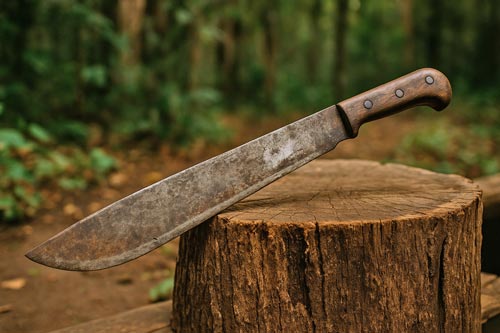
From its humble beginnings as a farming tool to its rise as a global symbol of resilience and power, the machete has carved out a unique place in human history. It's one of the few tools that connects ancient craftsmanship with modern innovation, serving farmers, soldiers, explorers, and filmmakers alike. Every nick and scratch on a machete's blade tells a story of hard work and survival, reminding us that the simplest tools often have the greatest impact.
Whether you're fascinated by its history, inspired by its role in culture, or looking for a dependable tool for the outdoors, the machete stands as proof that utility and artistry can exist in perfect balance. If this legendary blade has captured your interest, take a closer look at the designs available in our machetes section. From jungle clearing to movie making, the machete continues to earn its reputation as one of the world's most trusted blades.
You May Also Be Interested In:
- History of the Baton: From Police Nightstick to Self-Defense Tool
- The Real History of Nunchaku: From Farm Tool to Martial Arts Icon
- The History of the Karambit: From Indonesian Farm Tool to Modern Tactical Icon
- Which Weapon Would You Choose to Survive a Horror Movie?
- Black Ops Machete and Other New Weapons
- Kukri vs Machete: What's the Real Difference?
- The Evolution of the Bowie Knife: From Frontier Tool to Collectible Icon
- A Brief History of Kung Fu
- A Brief History of Judo
- The Untold History of Female Ninjas: Secrets of the Kunoichi
Leave a Reply
























